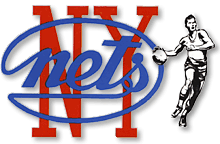
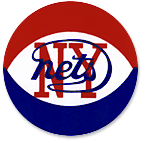

|
New York Nets2012 NBA/ABA Throwback Uniforms -
|
Back to "Remember the ABA" Main Page
Did you see a New York Nets game? Or, did you have a favorite ABA Nets player? Contribute to this web page by
In 1973, Julius ("Dr. J") Erving came back to New York -- his hometown -- and kindled nationwide interest in the red, white and blue league. To many basketball fans, Erving's colorful highwire act with the Nets became the image of the ABA itself. During his three years with the team, Erving won the ABA MVP Award three times. The Nets won the ABA title two out of those three years.
Before Erving's arrival, though, the franchise went through some lean times. For the Nets, the road to respectability was a long one.
After the ABA's first year (1967-68), the troubled New Jersey Americans franchise moved to Long Island and became the New York Nets. The "Nets" nickname was picked because it rhymed with "Mets" and "Jets."
The Nets were pitiful in
the 1968-69 season, winning only 17 games. This was the
worst record in the ABA, even below the pitiful Houston Mavericks.
The roster was shuffled and reshuffled numerous
times during the season as the Nets fell further and further below
.500. Over
the course of the year, the Nets' roster included - in no particular
order - Bobby
Lloyd, Walt Simon, Manny Leaks, Oliver Darden, Tom Hoover, Kenny
Wilburn, Stew Johnson, Hank Whitney, Randy Mahaffey, Dan Anderson,
Ron Perry, Steve Chubin, Bob Verga, Tony Koski, Wilbert Frazier,
Tom Bowens, Tony Jackson, Willie Worsley, Levern Tart, and Rodney
Knowles. Incredibly, 23 different players suited up
for the Nets for the 1968-69 season. The frequent changeover in
talent didn't help at all.
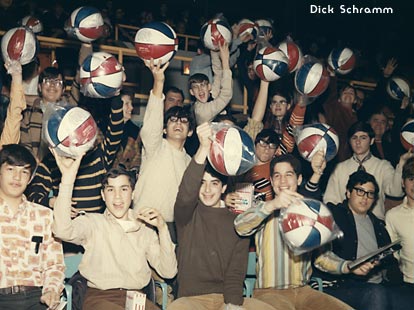 Attendance was absolutely terrible, rarely eclipsing the
1,000 mark. On October 29, 1968, the Nets drew only 384 people for their home contest against the Denver Rockets. On December 25, 1968, the Rockets returned to Long Island for another game with New York. This time, due to the Christmas holiday and complete lack of interest in the Rockets, only 249 fans bothered to show up.
Attendance was absolutely terrible, rarely eclipsing the
1,000 mark. On October 29, 1968, the Nets drew only 384 people for their home contest against the Denver Rockets. On December 25, 1968, the Rockets returned to Long Island for another game with New York. This time, due to the Christmas holiday and complete lack of interest in the Rockets, only 249 fans bothered to show up.
In a complete turnaround, an impressive 3,814 people showed up only two days later to see the Nets face Rick Barry and the powerful Oakland Oaks (this was the infamous game during which the Nets' Kenny Wilburn undercut Barry on a 4th-quarter fast break, causing Barry to suffer a season-ending knee injury). But things soon returned to "normal," as only 516 fans attended the December 29, 1968 game against the Kentucky Colonels. During the rest of this dismal season, crowds generally hovered around the 600-700 mark.
The poor attendance was partly because of the team's lack of name stars, partly because of the constant losing, and partly because the Nets played their home games in Commack Arena -- a cold, dark structure reminiscent of a huge airplane hangar. Ironically, the team had forfeited its previous year's playoff game due to unplayable conditions at Commack. In 1969, Basketball Weekly reported that: "The court [at Commack] is placed over an ice rink and at times moisture seeps through the floor. Also, the areas behind the baskets are not fully covered and players driving in for layups often wind up on the ice. The Nets' Levern Tart suffered a broken cheekbone when he took a dive on the ice." Tart remembers seeing Denver Rockets players don gloves and overcoats while on the bench during a game.
About the only time the Nets could count on a semi-respectable crowd was when the team held a special "ABA Ball Night" (photo of excited participants at above left) The Nets quickly learned that a free red, white and blue basketball was a sure-fire way of attracting swarms of kids - and their parents/scoutmasters - to a home game featuring a relatively unknown ABA opponent.
Before attending ABA Ball Night, most kids could not name a single Net, or any ABA player for that matter. But after receiving a replica ABA basketball and braving a freezing evening at Commack, at least some of them started to have an interest in the Nets and the ABA. During the remainder of the season, they pestered their parents to attend more games. Occasionally, the parents actually complied -- despite the sorry state of the team and its facilities. In this way, the Nets began to cultivate a small but loyal fan base. This early form of marketing helped keep the team afloat in a tough market, under very difficult circumstances.
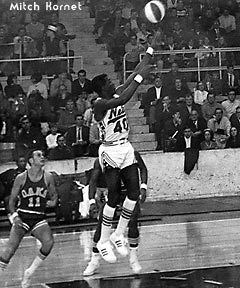 |
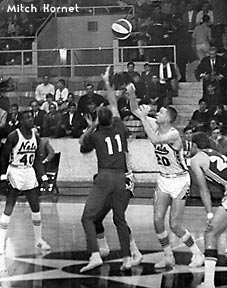 |
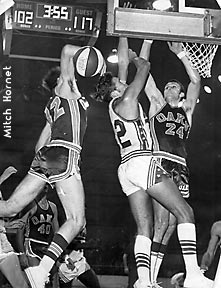 |
| Thanks
to Mitch Kornet, here
are some ultra-rare snapshots of the 1968-69 New York Nets
playing in their "icebox" known as Commack Arena (notice
the hockey boards behind the action). At the beginning of the 1968-69 season, the team looked just like its immediate predecessor, the New Jersey Americans. With the exception of the scripted "Nets" on the front, the uniforms looked exactly the same - even down to the shorts. The Nets' court and scoreboard (above middle and above right) were imported directly from the Teaneck Armory. The players were familiar too - Levern Tart (above left # 40, with the fingerroll against the Oaks' Larry Brown) was still jacking up shots from everywhere - and making them. Dan Anderson (above middle, # 20, with the center jump) was still trying his best to anchor the middle. But these familiar faces didn't get very comfortable at Commack. Management undertook a purge of almost all of the remaining Americans after the Nets' terrible start. After only 25 games, Anderson was shipped to the Kentucky Colonels. Tart's turn came soon after that - he was sent to the Houston Mavericks. In December the team brought in a parade of new players. Ron Perry (above right, # 22) came from the Miami Floridians. Bob Verga (right, # 27) came from the Denver Rockets. But even these new players didn't last the year - on January 31, 1969 the Nets traded Verga to the Houston Mavericks and Perry to the Indiana Pacers. This turnover was not unusual - over the course of the 1968-69 season, an amazing 23 different players wore a Nets uniform. |
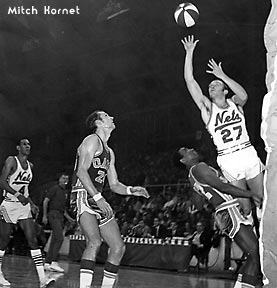 |
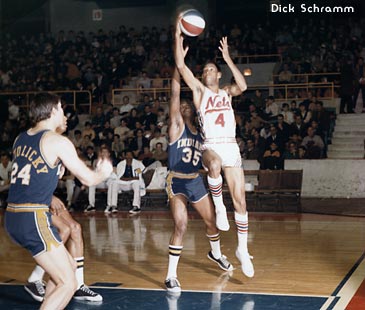 In
late February, Max Zaslofsky finally had enough - he informed the
team that he would resign as Nets coach, effective at the end of
the year. After
being asked why he was quitting, Zaslofsky stated that certain "limitations
of the job" made him feel incapable
of improving the Nets' lowly position. Following Zaslofsky's announcement,
owner Arthur Brown told the media that he had "roughly 40" applicants
for the coaching position - most local reporters viewed this as ...
shall we say ... "unlikely."
In
late February, Max Zaslofsky finally had enough - he informed the
team that he would resign as Nets coach, effective at the end of
the year. After
being asked why he was quitting, Zaslofsky stated that certain "limitations
of the job" made him feel incapable
of improving the Nets' lowly position. Following Zaslofsky's announcement,
owner Arthur Brown told the media that he had "roughly 40" applicants
for the coaching position - most local reporters viewed this as ...
shall we say ... "unlikely."
The Nets best and most consistent player during the 1968-69 season was Walt Simon (#4 at right, driving against Roger Brown of the Pacers) - one of the few original Americans who managed survive the roster turnover. Simon averaged eight rebounds per game to go along with his 20.5 ppg scoring average. Observers noted his good outside jumper, with a quick release. He also had the speed and the hands to rank among the best driving forwards in the ABA. Finally, he was unselfish - he led the Nets in assists. Simon wasn't shy about voicing his frustration with the team's constant losing and poor situation: "The first thing is I get mad. I've lost my temper and told some of my teammates I didn't think they were going as hard as I think they can." On his future with the team, Simon was blunt, saying that: "We're going to be getting a new coach next year. I don't know whether he'll think I fit into his system. Maybe he'll want to change the whole ball club around, bring in all new players. The way we've lost this year, that could easily happen. I'm sure I'll be playing in the ABA next year, but not necessarily for this team."
What really made the difference in the Nets' third year and beyond was that Roy Boe bought the team from its original owner, Arthur Brown in the summer of 1969. Boe was the owner of "Boe Jests," a multi-million dollar garment industry firm. Boe was willing to spend money on the Nets, and his attitude quickly paid dividends.
Boe immediately moved the Nets' home games from the ever-chilly Commack to the Island Garden in Hempstead (Long Island). The Island Garden was a "cozy" arena which normally held only 4,000 to 5,000 people. One side of the court had a normal complement of grandstand seating. The other side of the court had only a few rows of seating - in front of a large blue curtain with a large "Nets" logo affixed in the middle (see photo below). It was a strange setup, especially with the curtain. The Garden conveyed the impression of a high school gymnasium. But in the Garden, the fans were always close to the action, and all the seats were good ones. And, extra seats could always be added for special or important games, raising the arena's capacity to 8,500.
Boe also addressed the Nets' murky coaching situation. He
hired respected St. John's coach Lou Carnesecca to coach the team. But
since Carnesecca still had one year left on his St. John's contract, York
Larese became the head coach for the 1969-70 season only.
The 1969-70 season turned out to be a "milestone" season for the franchise
in many respects.
Levern
Tart returned to the team after being exiled to Houston the year
before. He came from the Denver Rockets in a cash deal that turned out to be a true bargain. Tart easily stepped back into his role
as the Nets' high scorer, averaging over 24 points per game. In the late stages of any game, Tart was
always the Nets' "go to" player. He also continued his role as the Nets' fan favorite - mobs of young fans always surrounded him before and after every home game. Tart became known as the Nets' "Autograph King." Walt Simon stayed with the Nets
- despite the prior year's turmoil - and had another consistent and
productive season. He was the only player to have remained with the team from its Teaneck/New Jersey origins. ABA
veteran Les "Big
Game" Hunter
was acquired from the Miami Floridians. Hunter made a huge difference
with extra scoring and rebounding. Newcomer Bill
Melchionni (left, # 25) also made a strong impression. Melchionni
came to the team as a free agent guard after being cut from the NBA Philadelphia
76ers. During
the 1969-70 season, he dished out 457 assists and averaged 15.2 ppg,
making the 76ers regret the day they let him go. Finally, "Easy" Ed Johnson filled the center position after being acquired in a cash deal with the Los Angeles Stars. In only his second year in the ABA, Johnson became one of the league's better rebounders. He also gave the Nets some inside scoring punch, developing some tremendous moves out of the post.
With these players, plus important role players
like Luther Green (rookie from Long Island University),
Sonny Dove (NBA vet from the Detroit Pistons), Billy Evans (rookie from Boston College) and Ron Taylor (backup center), the team was dramatically
improved on the court. In early January, they won their 18th game,
beating their entire victory total for 1968-69.
By the end of the 1969-70 regular season the Nets had won 39 games
Attendance-wise, things also took a significant turn for the better. In November 1969, crowds hovered around the 2,000 mark, already an
improvement from the previous year. In late December, the Nets actually
passed the previous year's total attendance. On January 18, 1970, the
Nets set a new record for home attendance at a single game when 4,671
enthusiastic fans turned out at the Island Garden for a Sunday afternoon
game against the red-hot Indiana Pacers. That record was shattered
only ten days later, when 5,200 fans showed up on ABA Ball Night (always
the most popular Nets promotion) to see the Kentucky Colonels.
The new enthusiasm carried over to something that was a brand new experience for Nets fans - the ABA playoffs. In the very first full playoff series for the team, the Nets bowed out against the Kentucky Colonels in seven hard-fought contests that actually drew some of New York's hardcore basketball fans. Even with the playoff defeat, most observers felt that the Nets had finally "turned the corner" as a viable ABA franchise.
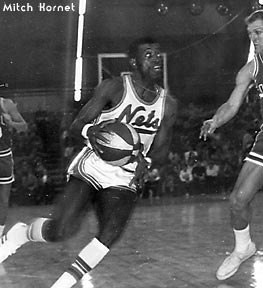 |
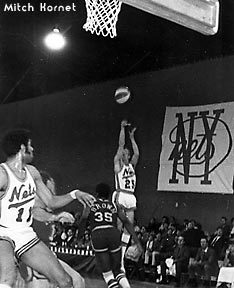 |
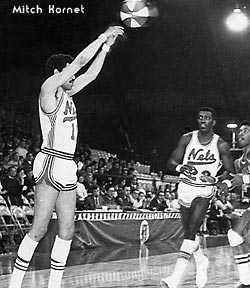 |
In
the early days at the Island Garden, Nets games were
attended by an endless supply of cub scouts, plus some
hardcore pro basketball fans.
The 1969-70 Nets had some interesting characters. Levern Tart (above left and left, #23) returned to New York and resumed his role as a free-spirited high-scoring gunner, who was also a fan favorite. During the 1969-70 season, Tart averaged a healthy 24.1 points per game. Bill Melchionni (above middle, #25) also came on board during the 1969-70 season. Melchionni gave the Nets some badly-needed stability at the guard position. Melchionni was good enough to stay with the Nets for another six seasons (he even played in the very last ABA game, in May 1976). In the eyes of many longtime Nets fans, Melchionni is the "face" of the ABA Nets. His number 25 was retired by the Nets after they joined the NBA. Sonny
Dove (above right and left, # 11) came to the Nets from the NBA Detroit
Pistons. His best years in pro basketball came with the Nets. |
For the 1970-71 season, Carnesecca finally came on board. Boe also acquired superstar and future Hall-of-Famer Rick Barry from the Virginia Squires. This move gained instant respect for the franchise around the country and, more importantly, in the New York area itself. Boe also signed good young players like Billy Paultz, Jim Chones, and Ollie Taylor. On the court, Barry met all expectations. He made the Nets a dangerous team, averaging 29.4 points per game (second in the ABA, behind only Dan Issel). For the second straight year, the Nets improved in the win column (going 40-44) and made the playoffs. However, they once again lost in the first round -- this time in a tough series with the Virginia Squires.
In 1971-72, everything finally seemed to come together for the Nets. They signed guard John Roche, who had been a three-time All-American at South Carolina (and the MVP of the Atlantic Coast Conference). Tom "Trooper" Washington was brought in to provide some help on the boards. Barry stayed healthy the entire season, and averaged an impressive 31.5 points per game (second in the ABA, behind only Charlie Scott). The Nets achieved their very first winning season, going 44-40. Late in the regular season, they left the Island Garden (capacity 8,500) and moved into the Nassau Coliseum, a sparkling, brand-new 17,800 seat facility. Attendance increased.
|
Next, the Nets faced Julius Erving and the favored Virginia Squires in the Eastern Division Finals. The Squires easily won the first two games in Virginia, with Dr. J scoring 26 points in Game 1 and 38 points in Game 2. It looked like the Nets were on the ropes. But, in a bizarre turn of events, the series was delayed for 10 days after Game 2. The delay occurred because Nassau Coliseum was booked (and nobody wanted any playoff games to take place at the Island Garden). The long layoff enabled the Nets to regroup and heal some injuries. When the series finally resumed, the Nets took both games at home to even the series at 2 games apiece. The teams traded victories in Game 5 and 6 to leave the series tied 3-3. The decisive Game 7 was at Norfolk in front of 10,410 fans, and Julius Erving had a big game (35 points). But behind a Rick Barry three-pointer in the final minute, the Nets prevailed 94-88 and moved on. Finally, in the ABA Championship Series, the Nets lost to the Indiana Pacers, but gave Indiana all it could handle in six hectic games.
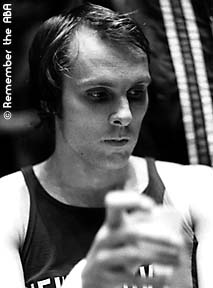 |
| At
the end of the 1971-72 season, Nets coach Lou Carnesecca finally had
some fun as a professional coach.
As a low seed, the Nets did not have the home-court advantage against anybody. But behind the ever-consistent Rick Barry (#24, above left and above middle), rookie miracle-worker John Roche (#13, above right), and super-leaper Ollie Taylor (#22, left), the Nets steamrolled through the 1972 ABA Playoffs. Roche stepped into a starting role in the Kentucky series after Bill Melchionni broke his hand on the last weekend of the regular season. Roche (32 ppg average in the series) and Barry (50 points in Game 1, and 32 ppg average in the series) scored at will to fuel the upset. In the Eastern Division finals against the Squires, Barry went head-to-head against heralded rookie Julius Erving. Behind Barry's three-point shooting and Billy Paultz's work in the middle, the Nets prevailed in seven hard-fought games. In the 1972 ABA Finals, the Nets were competitive but lost to the Pacers. |
The 1972-73 season was a step backwards for the franchise. Barry's contract with the Nets had come to an end at the conclusion of the 1971-72 season. Barry wanted to stay in New York. But in a stinging blow to the Nets, a U.S. District Court Judge ruled that if Barry wanted to play basketball in 1972-73, he would have to play for the NBA Golden State Warriors. Barry could have sat out the 1972-73 campaign, and then played for the Nets in 1973-74. However, Barry was not eager to sit out another season (he had missed the 1967-68 season under similar circumstances). Barry decided to return to the Warriors. Without Barry, the team stumbled to a 30-54 record. Although the Nets made the playoffs for the fourth straight season, they bowed out in five games to the Carolina Cougars. One of the bright spots that season was guard Brian Taylor, a rookie out of Princeton. Taylor captured the ABA Rookie of the Year Award, averaging 15.3 points per outing. Other players who came and went that year were John Baum, Gary Gregor, George Carter and Joe DePre.
|
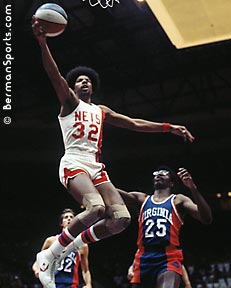 |
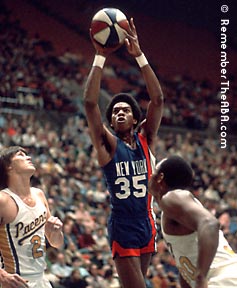 |
|
The
1973-74 ABA Champion Nets were strongly anchored by these five players.
Julius Erving (#32, above left) won the ABA MVP award that year (his first year with the Nets). Dr. J carried the Nets night in and night out. 6'9" forward Larry Kenon (#35, above middle), was an ABA all-rookie and All-Star selection in 1973-74. Known as "Mr. K," Kenon established a reputation as one of the finest offensive rebounders in the ABA. "The Whopper" Billy Paultz (above right, setting a pick) provided a physical presence in the middle, averaging just over two blocks and ten rebounds per game. And rookie guard "Super John" Williamson (#23, above right) dominated games with his physical play. Second-year guard Brian Taylor (#14, left) was a defensive-stopper and a three-point shooting wizard. |
In 1974-75, the Nets looked forward to defending their title. For most of the season, the prospects for a repeat looked good, as the Nets remained comfortably in first place in the Eastern Division. Incredibly, though, the Kentucky Colonels won 22 of their last 25 regular season games, and managed to catch the Nets at the wire. New York and Kentucky both ended up with 58-26 records, and a special one-game playoff was played at Kentucky to determine the division champion. The Nets lost to the red-hot Colonels 108-99, and then proceeded to lose an incredible first round series to the Spirits of St. Louis (a team the Nets had beaten in every regular season meeting), 4 games to 1. Observers noted that the Nets had relied on Erving too much during the regular season, and coach Loughery agreed: "We asked the Doctor to do too much for us. He was our leading scorer and rebounder. He got the rebound, triggered the fast break and was at the other end for the layup. By the time the playoffs came, he was too tired."
The Nets tried to remedy this situation by making some blockbuster trades. Swen Nater, Chuck Terry, Kim Hughes, and Rich "House" Jones were obtained from the San Antonio Spurs, in exchange for Larry Kenon, Mike Gale, and Billy Paultz. The idea was to obtain some much-needed rebounding help for Erving. Nater later was traded to Virginia for "Jumbo" Jim Eakins, and Ted McClain was acquired from Kentucky. When the dust cleared, the Nets remained a powerful team in 1975-76. They won at least 55 games for the third straight year, going 55-29.
Although the Nets finished 5 games behind the Denver Nuggets in the regular season race, Erving was rested by the time the playoffs came around. In the ABA Semifinals, the Nets outlasted the Spurs 4 games to 3 in an emotional, grueling series. Then, the Nets beat the Nuggets in the last ABA Championship Series, 4 games to 2.
(Streaming RealAudio File - call by and copyright Bob Lederer and used with permission) |
During the summer of 1976, the Nets became one of only four ABA teams (along with Denver, San Antonio and Indiana) to survive and enter the NBA. The terms of the NBA/ABA merger were harsh for all four ABA entrants, but particularly severe for the Nets. Each of the former ABA teams had to pay $3.2 million to join the NBA. The former ABA teams were not allowed to participate in the 1976 NBA Draft, and could not share in any NBA television money for three years. In addition, because the Nets would play in the "territory" of the New York Knicks, the terms of the merger dictated that the Nets had to pay the Knicks an additional $4.8 million. Faced with a financial nightmare (and some new contract problems with Erving), Roy Boe decided to sell Dr. J to the Philadelphia 76ers for several million dollars. The proceeds allowed New York to enter the NBA and survive. But, the arrangement took away the best player in pro basketball from the Nets. Without the Doctor, the Nets struggled to only 22 wins in their inaugural NBA season (1976-77). After that dismal season, the Nets moved to New Jersey, became the "New Jersey Nets," and continued to flounder.
After the merger, the Nets did not win an NBA division title (or make it to the NBA Eastern Conference Finals) until the 2001-2002 season.
OFF-SITE NETS ARTICLES AND NEWS
American Academy of Achievement Interview with Julius Erving (© 1997 American Academy of Achievement)
American Academy of Achievement Julius Erving Biography (©1997 American Academy of Achievement)
Nets 1969-72 Home Uniform |
Nets 1969-72 Road Uniform |
Nets 1972-76 Home Uniform |
Nets 1972-76 Road Uniform |
1967-68 Season (New Jersey Americans)
Record: 36-42, Tied for Fourth Place in Eastern Division
1968 Playoff Results:One Game Playoff at New Jersey vs. Kentucky Colonels (36-42) for Fourth Place and Playoff Berth
Colonels won by Forfeit, 2-0, due to unplayable conditions
Record: 17-61, Fifth Place in Eastern Division
Missed Playoffs
Record: 39-45, Fourth Place in Eastern Division
1970 Playoff Results:Eastern Division Semifinals vs. Kentucky Colonels (39-45)
Colonels won series, 4-3
Record: 40-44, Fourth Place in Eastern Division
1971 Playoff Results:Eastern Division Semifinals vs. Virginia Squires (45-39)
Squires won series, 4-2
Record: 44-40, Third Place in Eastern Division
1972 Playoff Results:Eastern Division Semifinals vs. Kentucky Colonels (68-16)
Nets won series, 4-2Eastern Division Finals vs. Virginia Squires (45-39)
Nets won series, 4-3ABA Championship vs. Indiana Pacers (47-37)
Pacers won series, 4-2
Record: 30-54, Fourth Place in Eastern Division
1973 Playoff Results:Eastern Division Semifinals vs. Carolina Cougars (57-27)
Cougars won series, 4-1
Record: 55-29, First Place in Eastern Division
1974 Playoff Results:Eastern Division Semifinals vs. Virginia Squires (28-56)
Nets won series, 4-1Eastern Division Finals vs. Kentucky Colonels (53-31)
Nets won series, 4-0ABA Championship vs. Utah Stars (51-33)
Nets won Championship, 4-1
Record: 58-26, Tied for First Place in Eastern Division
1975 Playoff Results:One Game Playoff At Louisville vs. Kentucky Colonels (58-26) for First Place in Eastern Division
Colonels won 108-99Eastern Division Semifinals vs. Spirits of St. Louis (32-52)
Spirits won series, 4-1
Record: 55-29, Second Place
1976 Playoff Results:Semifinals vs. San Antonio Spurs (50-34)
Nets won series, 4-3ABA Championship vs. Denver Nuggets (60-24)
Nets won Championship, 4-2
Record: 22-60, Fifth Place in Atlantic Division
Missed Playoffs